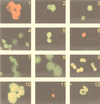Fluorescent oligonucleotide probes for clinical and environmental detection of Acanthamoeba and the T4 18S rRNA gene sequence type
- PMID: 10405422
- PMCID: PMC85314
- DOI: 10.1128/JCM.37.8.2687-2693.1999
Fluorescent oligonucleotide probes for clinical and environmental detection of Acanthamoeba and the T4 18S rRNA gene sequence type
Abstract
The first genus- and subgenus-specific fluorescent oligonucleotide probes for in situ staining of Acanthamoeba are described. Sequences of these phylogeny-based probes complement the 18S rRNA and the gene encoding it (18S rDNA). The genus-specific probe (GSP) is a fluorescein-labeled 22-mer specific for Acanthamoeba as shown here by its hybridization to growing trophozoites of all 12 known Acanthamoeba 18S rDNA sequence types and by its failure to hybridize with amoebae of two other genera (Hartmannella vermiformis and Balamuthia mandrillaris), two human cell lines, and two bacteria (Pseudomonas aeruginosa and Escherichia coli). The sequence type T4-specific probe (ST4P) is a rhodamine-labeled 30-mer specific for Acanthamoeba 18S rDNA sequence type T4, as shown here in hybridization tests with trophozoites of all 12 sequence types. T4 is the subgenus group associated most closely with Acanthamoeba keratitis (AK). GSP also was tested with corneal scrapings from 17 patients with a high index of clinical suspicion of AK plus 5 patient controls. GSP stained both trophozoites and cysts, although nonspecific cyst wall autofluorescence also was observed. Results could be obtained with GSP in 1 to 2 days, and based on results from cell culture tests, the probe correctly detected the presence or absence of Acanthamoeba in 21 of 24 specimens from the 22 patients. The use of GSP with cultured trophozoites and cysts from corneal scrapings has illustrated the suitability of using fluorescent oligonucleotide probes for identification of the genus Acanthamoeba in both environmental and clinical samples. In addition, the use of ST4P with cultured amoebae has indicated the potential of oligonucleotide probes for use in subgenus classification.
Figures
References
-
- Bacon A S, Dart J K, Ficker L A, Matheson M M, Wright P. Acanthamoeba keratitis. The value of early diagnosis. Ophthalmology. 1993;100:1238–1243. - PubMed
-
- Bacon A S, Frazer D G, Dart J K, Matheson M, Ficker L A, Wright P A. A review of 72 consecutive cases of Acanthamoeba keratitis, 1984–1992. Eye. 1993;7:719–725. - PubMed
-
- Byers, T. J. 1 April 1998, posting date. 18S rDNA sequence alignments. [Online.] http://www.biosci.ohio-state.edu/∼tbyers/byers.htm.
-
- Byers T J, Akins R A, Maynard B J, Lefken R A, Martin S M. Rapid growth of Acanthamoeba in defined media; induction of encystment by glucose-acetate starvation. J Protozool. 1980;27:216–219. - PubMed
Publication types
MeSH terms
Substances
Grants and funding
LinkOut - more resources
Full Text Sources
Miscellaneous


